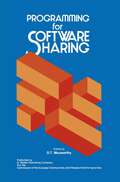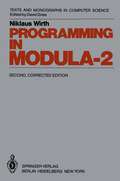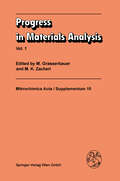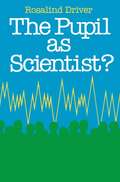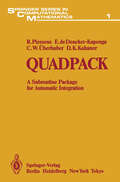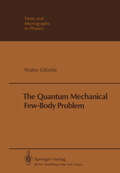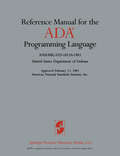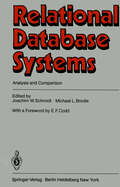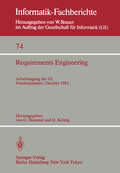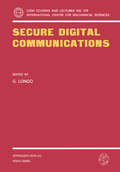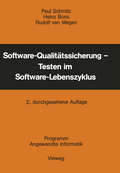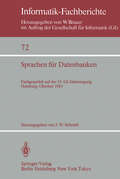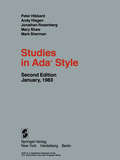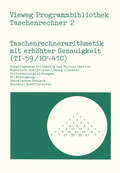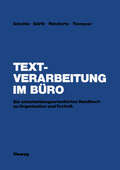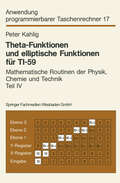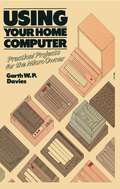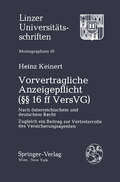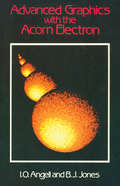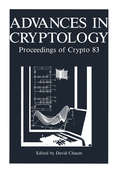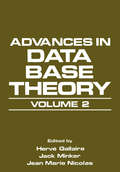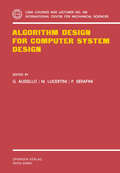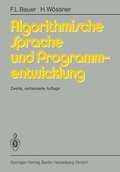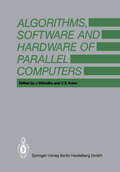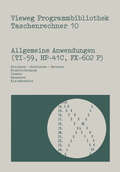- Table View
- List View
Programming for Software Sharing (Ispra Courses)
by D. T. MuxworthyMost computer users are familiar with the problems of sharing software with others, and the transfer of programs from one computing environment to another. Software represents an ever-increasing proportion of the cost of computing and these costs tend to nullify all the economic advantages flowing from the wider availability of cheap hardware. Years ago it was hoped that the widespread use of high-level programming languages would help in alleviating the problems of software production, by increasing productivity and by making it simpler for users with similar problems to be able to use the same programs, possibly on different types of machines. It is a common experience that in practice this simple optimism has proved to be unfounded. It was these considerations which led us in 1979 to organize a two-week course on "Programming for Software Sharing" at the European Community Joint Research Centre, Ispra Establishment (Italy), forming part of the regular series of "Ispra Courses". With prominent invited lecturers, local contributions and through discussion sessions we examined with an audience from many countries the problems involved in the sharing and transfer of software, as well as suggesting ways of overcoming them. In our local environment we are faced daily with three problems both from engagements in software exchange in the scientific-technical field on a Europe-wide or world-wide basis, and from work with programming techniques and contributions to the international standardization process.
Programming in Modula-2 (Monographs in Computer Science)
by N. WirthThis text is an introduction to programming in general, and a manual for programming with the language Modula-2 in particular. It is oriented primarily towards people who have already acquired some basic knowledge of programming and would like to deepen their understanding in a more structured way. Nevertheless, an introductory chapter is included for the benefit of the beginner, displaying in a concise form some of the fundamental concepts of computers and their programming. The text is therefore also suitable as a self-contained tutorial. The notation used is Modula-2, which lends itself well for a structured approach and leads the student to a working style that has generally become known under the title of structured programming. As a manual for programming in Modula-2, the text covers practically all facilities of that language. Part 1 covers the basic notions of the variable, expression, assignment, conditional and repetitive statement, and array data structure. Together with Part 2 which introduces the important concept of the procedure or subroutine, it contains essentially the material commonly discussed in introductory programming courses. Part 3 concerns data types and structures and constitutes the essence of an advanced course on programming. Part 4 introduces the notion of the module, a concept that is fundamental to the design of larger programmed systems and to programming as team work. The most commonly used utility programs for input and output are presented as examples of modules. And finally, Part 5 covers facilities for system programming, device handling, and multiprogramming.
Progress in Materials Analysis: Vol. 1 (Mikrochimica Acta Supplementa #10)
by M. Grasserbauer M. K. ZacherlThe 11th Colloquium on Metallurgical Analysis - a joint venture of the Institute of Analytical Chemistry of the Technical University in Vienna, the Austrian Society for Analytical Chemistry and Microchemistry, the German Metals Society (DGM), and the Society of German Iron and Steel Engineers (VDEh) - was attended by 120 scientists from 12 nations. The major topics covered were surface, micro and trace analysis of materials with a heavy emphasis on metals. According to the strategy of the meeting attention was focussed on an interdisciplinary approach to materials science - combining analytical chemistry, solid state physics and tech nology. Therefore progress reports on analytical techniques (like SIMS, SNMS, Positron Annihilation Spectroscopy, AES, XPS) were given as well as pre sentations on the development of materials (like for the fusion reactor). The majority of the discussion papers centered on the treatment of important technical problems in materials science and technology by a (mostly sophis ticated) combination of physical and chemical analytical techniques. The intensive exchange of ideas and results between the scientists oriented towards basic research and the industrial materials technologists was very fruitful and resulted in the establishment of several scientific cooperations. Major trends in materials analysis were also dealt with in a plenary discussion of which a short summary is contained in this volume. In order to facilitate international communication in the field of materials analysis and in view of the important questions treated in the various contri butions this proceedings volume was edited in English.
Pupil As Scientist (UK Higher Education OUP Humanities & Social Sciences Education OUP)
by Rosalind DriverThe Pupil as Scientist intends to give teachers and student teachers a better understanding of the thinking of young adolescent pupils in science lessons and to indicate the difficulties such pupils have in understanding the more abstract or formal ideas with which they are presented. It is practical in its orientation as the issues discussed are illustrated with examples drawn from dialogue and observations made in science classes.One of Rosalind Driver's main themes is that science teachers must recognise more fully and act upon the preconceptions and alternative frameworks which pupils bring to their study of science.Despite is practical orientation, the book addresses some fundamental questions arguing for a reappraisal of science teaching in secondary schools in the light of developments in cognitive psychology and philosophy of science.This is an accessible, authoritative and very helpful book for all concerned with the teaching of science in the secondary years.
Quadpack: A Subroutine Package for Automatic Integration (Springer Series in Computational Mathematics #1)
by R. Piessens E. de Doncker-Kapenga C.W. Überhuber D.K. Kahaner1. 1. Overview of Numerical Quadrature The numerical evaluation of integrals is one of the oldest problems in mathematics. One can trace its roots back at least to Archimedes. The task is to compute the value of the definite integral of a given function. This is the area under a curve in one dimension or a volume in several dimensions. In addition to being a problem of great practi cal interest it has also lead to the development of mathematics of much beauty and insight. Many portions of approximation theory are directly applicable to integration and results from areas as diverse as orthogo nal polynomials, Fourier series and number theory have had important implications for the evaluation of integrals. We denote the problem addressed here as numerical integration or numerical quadrature. Over the years analysts and engineers have contributed to a growing body of theorems, algorithms and lately, programs, for the solution of this specific problem. Much effort has been devoted to techniques for the analytic evalua tion of integrals. However, most routine integrals in practical scien tific work are incapable of being evaluated in closed form. Even if an expression can be derived for the value of an integral, often this reveals itself only after inordinate amounts of error prone algebraic manipulation. Recently some computer procedures have been developed which can perform analytic integration when it is possible.
The Quantum Mechanical Few-Body Problem (Theoretical and Mathematical Physics)
by W. GlöckleFew-body systems are both technically relatively simple and physically non trivial enough to test theories quantitatively. For instance the He-atom played historically an important role in verifying predictions of QED. A similar role is contributed nowadays to the three-nucleon system as a testing ground far nuclear dynamics and maybe in the near future to few-quark systems. They are also often the basic building blocks for many-body systems like to some extent nuclei, where the real many-body aspect is not the dominant feature. The presentation of the subject given here is based on lectures held at var ious places in the last ten years. The selection of the topics is certainly subjec tive and influenced by my own research interests. The content of the book is simply organized according to the increasing nu mb er of particles treated. Be cause of its conceptual simplicity single particle motion is very suitable for in troducing the basic elements of scattering theory. Using these elements the two-body system is treated for the specific case of two nucleons, which is of great importance in the study of the nuclear interaction. Great space is devoted to the less trivial few-body system consisting of three particles. Again physical examples are taken solely from nuclear physics. Finally the four particle system is discussed so as to familiarize the reader with the techniques required for the formulations of n-bodies in general.
Relational Database Systems: Analysis and Comparison
by Joachim W. Schmidt Michael L. BrodieAfter a long period of research, development, test and trial, relational database management systems are at last being marketed in force. The feedback from early installations of these systems is overwhelmingly positive. The most frequent comment by users is that productivity has been increased by a significant factor (from 5 to 20 times what it was using previous approaches). Another comment is that, in many cases, end users can now handle their own problems by direct use of the system instead of using application programmers as mediators between them and the system. As the reputation of relational systems for ease of use and enhanced productivity has grown, there has been a strong temptation for vendors of other approaches to exploit the label "relational" somewhat indiscriminately. In some cases the label is being misapplied to a whole data system; in others it is being misapplied to an interface. It is therefore worth developing criteria which database management systems (DBMSs) should have in order to be called "relational". The Relational Task Group (RTG) of the American National Standards Institute (ANSI) undertook such an effort by developing a characterization of RDBMSs and analyzing fourteen DBMSs per this characterization. The result of this work is presented in this book. The conclusions of the RTG are in agreement with my view that a DBMS should not be called "relational" unless it satisfies at least the following conditions: 1. All information in the database is represented as values in tables.
Requirements Engineering: Arbeitstagung der GI, Friedrichshafen, 12–14 Oktober 1983 (Informatik-Fachberichte #74)
by G. Hommel D. KrönigDie Arbeitstagung "Requirements Engineering für die Automatisierung von Systemen" wird vom Fachausschuß 4.3 "Requirements Engineering" der Gesellschaft für Informatik in Zusammenarbeit mit der Fachgruppe 4.4.1 "Systematisches Entwerfen von PDV-Systemen", einer gemeinsamen Fach gruppe von GI und VDI/VDE-GMR, und mit dem Fachausschuß 4.2 "Rechner gestütztes Entwerfen und Projektieren (CAE)" veranstaltet. Unter Requirements Engineering wird hier die ingenieurmäßige Ermitt lung der Anforderungen an die Automatisierung eines Systems und ihrer Aufarbeitung zur Realisierung in Hardware und Software verstanden. Es ist das erste Mal im deutschsprachigen Raum, daß speziell zu die sem Thema eine Tagung veranstaltet wird. Dies scheint gerechtfertigt durch das international zunehmende Interesse an dieser Problematik, welches offensichtlich aus den erheblichen Schwierigkeiten resultiert, die in der Praxis bei der Bewältigung dieser Aufgabe auftreten. Die Aufgabe wird häufig mit projektbezogenen Verfahren angegangen. Andererseits gibt es aber bereits theoretische Methoden zur systema tischen Anforderungserschließung, deren Einsatz in der industriellen Praxis jedoch noch Schwierigkeiten bereitet. In dieser Situation will die Arbeitstagung den Erfahrungsaustausch zwischen Theorie und Praxis fördern. Der Programmausschuß hat sich bemüht, unter den Vortragsan meldungen die Auswahl so zu treffen, daß einerseits der Stand der Tech nik und die vorliegenden Erfahrungen und andererseits Ansätze für zu künftige Entwicklungen in diesem Bereich erkennbar sind.
Software-Qualitätssicherung — Testen im Software-Lebenszyklus (Programm Angewandte Informatik)
by Paul SchmitzSprachen für Datenbanken: Fachgespräch auf der 13. GI-Jahrestagung Hamburg, 3. – 7. Oktober, 1983 (Informatik-Fachberichte #72)
by J. W. SchmidtTaschenrechnerarithmetik mit erhöhter Genauigkeit (Vieweg Programmbibliothek Taschenrechner #2)
by Peter G. PoloczekTextverarbeitung im Büro: Ein entscheidungsorientiertes Handbuch zu Organisation und Technik
by Erwin GrochlaTheta-Funktionen und elliptische Funktionen für TI-59: Mathematische Routinen der Physik, Chemie und Technik Teil IV (Anwendung programmierbarer Taschenrechner #17)
by Peter KahligDie speziellen Funktionen, insbesondere die elliptischen Funktionen, hatten in Physik und Technik stets ungeheure Bedeutung und wurden in den Vorlesungen der Hochschulen im 19. und be ginnenden 20. Jahrhundert entsprechend berücksichtigt. Später sind die speziellen Funktionen aus den Vorlesungen verschwunden, und es traten die strukturellen Gesichtspunkte der Mathematik in den Vordergrund. Dies hat zu einer gewissen Entfremdung zwischen Anwendungen und theoretischer Ausbildung im Vorlesungsbetrieb geführt. Allerdings haben im angelsächsischen Sprachraum die speziellen Funktionen stets durch Bücher und Tafelwerke Berücksichtigung gefunden, entsprechend ihrer Bedeutung sowohl für Anwendungen der Mathematik wie auch für theoretische Begriffsbildungen. Durch den Computer (bzw. seinen kleinen Bruder, den Taschenrechner) ist die Freude am numerischen Rechnen ganz bedeutend gestiegen. Wegen erhöhter Genauigkeitsansprüche in Physik· und Technik kann man sich heute nicht mehr mit linearen Näherungen begnügen (berühmtes Beispiel: das Pendel); dadurch braucht auch der Ingenieur und Physiker die speziellen Funktionen, im besonderen die elliptischen Funktionen. Es ist zu begrüßen, daß der Autor P. Kahlig, von dem schon analoge Veröffentlichungen vorliegen, einen Band über die elliptischen Funktionen und die Theta-Funktionen herausbringt, deren Bedeutung auch für die Wärmeleitung und Diffusion ja wohlbekannt ist. Genaue Funktionswerte sind somit jedem Anwender schnell und leicht zugänglich. Es ist diesem Band weite Verbreitung zu wünschen. Univ. Prof. Dr. Dr. h.c. Edmund Hlawka, Institut für Analysis, Technische Mathematik und Versicherungs mathematik der Technischen Universität sowie Institut für Mathematik der Universität Wien. Wirkl. Mitglied der Österr. Akademie der Wissenschaften, Mitglied der Deutschen Akademie der Naturforscher, korrespond.
Vorvertragliche Anzeigepflicht: Nach österreichischem und deutschem Recht. Zugleich ein Beitrag zur Vertreterrolle des Versicherungsagenten (Linzer Universitätsschriften #10)
by H. KeinertAnliegen des Versicherungsvertragsgesetzes war weine ange messene Ausgleichung zwischen den Interessen der Versicherer u und der Versicherungsnehmer (Begriindung zu den Entwiirfen des VersVG [1906] 4). Von diesem Streben nach ausgewogener Beriick sichtigung der berechtigten Interessen beider Gruppen lafit sich auch diese Monographie leiten. Sie untersucht einzelne, praktisch besonders wichtige Problemkreise der vorvertraglichen Anzeige pflicht, die von den moglichen Konsequenzen der Obliegenheits verletzung - der Arglistanfechtung durch den Versicherer, vor allem aber von seinem Riicktritt -her aufgerollt werden. Wie stets im Versicherungsrecht spielen Probleme des biirgerli chen Rechts eine besondere Rolle; dazu tritt seit 19'19 das Konsu mentenschutzgesetz. Von den daraus resultierenden, nicht allzu gewichtigen Unterschieden zum deutschen Recht abgesehen, ist die Untersuchung auch fUr dieses verwendbar, zumal das Versiche rungsvertragsgesetz, aber auch das Handelsgesetzbuch der deut schen und der osterreichischen Rechtsordnung in nahezu identi scher Fassung angehoren. Dazu kommt, daB versicherungsrechtli ches Arbeiten in Osterreich angesichts des iiberaus sparlichen eigenen Schrifttums weitestgehend auf die Auseinandersetzung mit deutscher Literatur und deutscher Rechtsprechung angewie sen ist.
Advances in Cryptology: Proceedings of Crypto 83
by David ChaumAn international community of researchers is now flourishing in the area of cryptology-there was none half-a-dozen years ago. The intrinsic fascination of the field certainly is part of the explanation. Another factor may be that many sense the importance and potential consequences of this work, as we move into the information age. I believe that the various meetings devoted to cryptology over the past few years have contributed quite significantly to the formation of this community, by allowing those in the field to get to know each other and by providing for rapid exchange of ideas. CRYPTO 83 was once again truly the cryptologic event of the year. Many of the most active participants continue to attend each year, and attendance continues to grow at a healthy rate. The informal and collegial atmosphere and the beach side setting which contribute to the popularity of the event were again supported by flawless weather. The absence of parallel sessions seemed to provide a welcome opportunity to keep abreast of developments in the various areas of activity. Each session of the meeting organized by the program committee is repre sented by a section in the present volume. The papers were accepted by the program committee based on abstracts, and appear here without having been otherwise refereed. The last section contains papers presented at the informal rump session. A keyword index and an author index to the papers is provided at the end of the volume.
Advances in Data Base Theory: Volume 2
by Hervé Gallaire Jack Minker Jean Marie NicolasThis is the third book devoted to theoretical issues in data bases that we have edited. Each book has been the outgrowth of papers held at a workshop in Toulouse, France. The first workshop, held in 1977 focused primarily on the important topic of logic and databases. The book, Logic and Databases was the result of this effort. The diverse uses of logic for databases such as its use as a theoretical basis for databases, for deduction and for integ rity constraints formulation and checking was described in the chapters of the book. The interest generated by the first workshop led to the deci sion to conduct other workshops focused on theoretical issues in databases. In addition to logic and databases the types of papers were expanded to include other important theoretical issues such as dependency theory which, although it sometimes uses logic as a basis, does not fit with our intended meaning of logic and databases explored at the first workshop. Because of the broader coverage, and because we anticipated further workshops, the second book was entitled, Advances in Database Theory - Volume 1. The book "Logic and Databases" should be considered Volume 0 of this series.
Algorithm Design for Computer System Design (CISM International Centre for Mechanical Sciences #284)
by Giorgio Ausiello M. Lucertini P. SerafiniAlgorithms, Software and Hardware of Parallel Computers
by J. Chudik G. David V. E. Kotov J. Miklosko N. N. Mirenkov J. Ondas I. Plander V. A. ValkovskiiBoth algorithms and the software . and hardware of automatic computers have gone through a rapid development in the past 35 years. The dominant factor in this development was the advance in computer technology. Computer parameters were systematically improved through electron tubes, transistors and integrated circuits of ever-increasing integration density, which also influenced the development of new algorithms and programming methods. Some years ago the situation in computers development was that no additional enhancement of their performance could be achieved by increasing the speed of their logical elements, due to the physical barrier of the maximum transfer speed of electric signals. Another enhancement of computer performance has been achieved by parallelism, which makes it possible by a suitable organization of n processors to obtain a perform ance increase of up to n times. Research into parallel computations has been carried out for several years in many countries and many results of fundamental importance have been obtained. Many parallel computers have been designed and their algorithmic and program ming systems built. Such computers include ILLIAC IV, DAP, STARAN, OMEN, STAR-100, TEXAS INSTRUMENTS ASC, CRAY-1, C mmp, CM*, CLIP-3, PEPE. This trend is supported by the fact that: a) many algorithms and programs are highly parallel in their structure, b) the new LSI and VLSI technologies have allowed processors to be combined into large parallel structures, c) greater and greater demands for speed and reliability of computers are made.
Allgemeine Anwendungen: Zeichnen — Sortieren — Rechnen, Elektrotechnik, Chemie, Bauwesen, Kleinkredite (Vieweg Programmbibliothek Taschenrechner #10)
by Norbert HoffmannI m Band 10 der Vieweg Programmbibliothek Taschenrechner wird nochmals die allgemeine Anwendung aus verschiedenen Bereichen aufgegriffen und programmtechnisch auf die Rechner TI-59, HP-41 C und FX-602P realisiert. Damit soll gleichzeitig eine Beendigung der Beiträge für den weit verbreiteten Rechner TI-59 signalisiert werden, die stets in großer Zahl den Herausgebern zur Veröffentlichung vorgelegt werden. Hierdurch wird dem Trend zur Anwendung von Rechnern mit erweiterten Möglichkeiten der Program mierung und Textverarbeitung Rechnung getragen. Andererseits ist jedoch auch eine Sättigung der den Herausgebern vorliegenden Beiträge hinsichtlich der Behandlung allgemeiner Anwendungen zu verzeichnen. Die inhaltliche Spannweite dieses Bandes reicht von Organisationsprogrammen für verschiedene Sortierprobleme über beispielhafte elektrotechnische und chemische Auf gabensteIlungen bis hin zu statistischen Berechnungen aus dem Bereich des Bauingenieur wesens. Er endet mit einem finanzmathematischen Beitrag über die Effektivzinsberech nung für Kleinkredite. Hierbei ist die programmtechnische Realisierung für die beiden Rechnertypen TI-59 und HP-41 C zum Vergleich angeboten. Möge auch dieser Band wieder möglichst vielen Benutzern der angesprochenen program mierbaren Rechner hilfreiche Anregungen für eigene Programmlösungen bieten und die hierzu nützlichen Kontakte mit den einzelnen Autoren ermöglichen.
